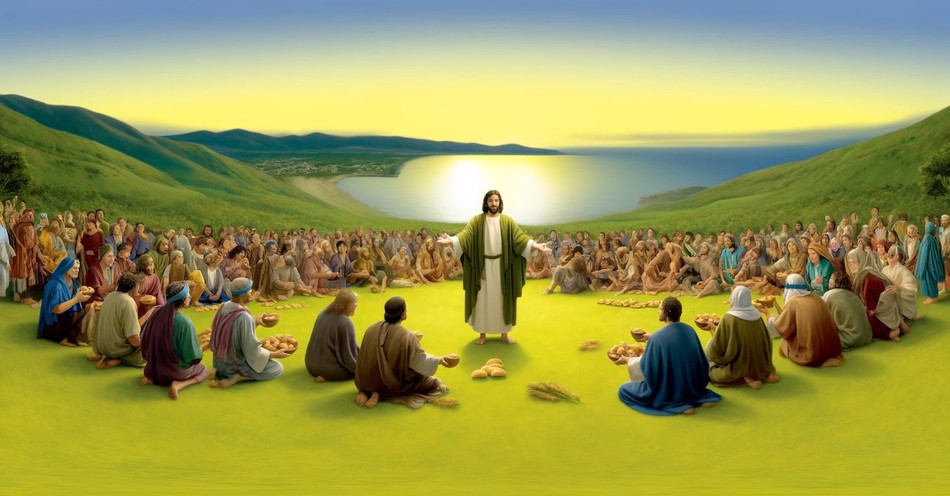One of the most popular records of Jesus Christ performing a great miracle is Jesus feeding the 5,000. This story is found in several books of the Bible such as Matthew 14:13-21. Let's read the story of when Jesus feeds the 5000 and then explore it's deeper meaning and significance.
When Jesus heard what had happened, he withdrew by boat privately to a solitary place. Hearing of this, the crowds followed him on foot from the towns. When Jesus landed and saw a large crowd, he had compassion on them and healed they’re sick.
As evening approached, the disciples came to him and said, “This is a remote place, and it’s already getting late. Send the crowds away, so they can go to the villages and buy themselves some food.”
Jesus replied, “They do not need to go away. You give them something to eat.”
“We have here only five loaves of bread and two fish,” they answered.
“Bring them here to me,” he said. And he directed the people to sit down on the grass. Taking the five loaves and the two fish and looking up to heaven, he gave thanks and broke the loaves. Then he gave them to the disciples, and the disciples gave them to the people. They all ate and were satisfied, and the disciples picked up twelve basketfuls of broken pieces that were leftover. The number of those who ate was about five thousand men, besides women and children.
Jesus Feeds the 5,000 Story
Found in all four Gospels (Matthew 14:13-21, Mark 6:30-44, Luke 9:10-17, and John 6:1-14), here is a summary of the event when Jesus feeds 5,000 people from five loaves of bread and two fish:
After hearing of the death of John the Baptist, Jesus withdraws by boat privately to a solitary place near Bethsaida. However, the crowds follow Him on foot from the towns. When Jesus lands and sees the large crowd, He has compassion on them and heals their sick.
As evening approaches, the disciples come to Jesus and suggest that He send the crowds away to the villages to buy themselves some food. Jesus responds by telling the disciples to give the crowd something to eat. The disciples are perplexed, pointing out that they only have five loaves of bread and two fish, brought forward by a boy in John's account.
Jesus instructs the crowds to sit down on the grass. He then takes the five loaves and the two fish, looks up to heaven, and gives thanks. He breaks the loaves and gives them to the disciples, and the disciples distribute the food to the people. Everyone eats and is satisfied.
Afterward, the disciples pick up twelve basketfuls of broken pieces that were leftover. The number of those who ate was about five thousand men, besides women and children.
This miracle is significant for several reasons. It demonstrates Jesus' compassion for the people, His power over nature, and His ability to provide for the needs of a multitude from very little. It is also seen as a sign pointing to Jesus as the Messiah, the Bread of Life, who provides spiritual nourishment to the world.
Significance and Symbolism
The miracle of Jesus feeding the 5,000, beyond being a profound display of God's compassion and power seen through the miracle power of Jesus, is rich in symbolism and significance, touching on several key themes in Christianity:
Divine Provision and Abundance: At the heart of the miracle is the theme of God's provision. Jesus' ability to feed a multitude with only five loaves and two fish symbolizes God's boundless generosity and care. It reassures believers of God's capacity to meet not only physical needs but spiritual hunger as well, often from seemingly meager resources.
Jesus as the Bread of Life: This miracle is directly linked to the concept of Jesus as the "Bread of Life," a theme especially prominent in the Gospel of John (John 6:35). The feeding of the 5,000 prefigures the Last Supper and the Eucharist, where bread and wine become the body and blood of Christ, offering spiritual nourishment and eternal life to believers.
The Kingdom of God: The miracle can be seen as a foretaste of the Kingdom of God, where there is no hunger, suffering, or want. The abundance in the story points to the eschatological promise of a future where God's provision is complete and universal.
Faith and Dependency on God: The disciples' initial response to the situation reflects human limitations and doubts. Jesus' instruction to feed the crowd with what little they have teaches a lesson in faith and reliance on God's power, even when solutions seem humanly impossible.
A Call to Trust and Act: The story is also a call to discipleship and ministry, reminding believers that with faith in Jesus, they are to participate in the work of the Kingdom. It encourages followers to bring their resources, no matter how small, to Jesus, trusting that He will multiply them to meet the needs around them.
Lessons from Jesus Feeding the 5000
The story of Jesus feeding the five thousand is one of the most inspiring stories in the Bible and it is often used to encourage brethren to believe in God’s great power and mercy.
What then does this miracle tell us about Jesus? What lessons can we learn from this passage? Let us delve into this miracle in detail to be able to understand it and also relate to it in our daily lives as we continue to follow Jesus.
1. Jesus’ Compassion
Jesus’ Feeding of the five thousand reminds us of Jesus’ compassion for His people. We see this in the first part of the passage when it is mentioned that Jesus was traveling and healing the sick at the same time. At the end of the day, the disciples wanted the crowd to go away because it was getting dark. But then Jesus said to them, let the people remain and instead give them some food.
The character of Jesus is exhibited in this part of the passage. His compassion is without bounds that even if He had traveled far, healed the sick, and did so many things, His priority was still the crowd that followed Him (John 3:16).
This scenario of Jesus feeding 5,000 people supports the fact that Jesus is the Lord that saves His Church. His compassion is so boundless that He gave His life for His children who are, by the way, sinners.
2. Jesus Uses Other People to Bless Others
Another lesson that we can learn from Jesus’ feeding of the five thousand is that Jesus uses other people to bless other people. An example of this is when Jesus asked his disciples to find food and found a boy who had five loaves of bread and two fish.
In this very moment, Jesus decides to use the boy for His miracle and turn the five loaves of bread and two fish into something the crowd would be enriched and fed. “Here is a boy with five small barley loaves and two small fish, but how far will they go among so many?” (John 6:9).
This scenario teaches us two things about Jesus’ ways. First is that He uses others, His disciples, in this case, to be his hands in providing blessings to others. He asks them to find food which they did by finding the boy.
The second one is that Jesus uses His children to help others. He encourages a simple boy to help a crowd of 5,000 through his five loaves of bread and fish. We can just imagine what amazement the boy had when his simple treasures become the reason for the crowd to be fed.
Jesus then took the loaves, gave thanks, and distributed to those who were seated as much as they wanted. He did the same with the fish. When they had all had enough to eat, he said to his disciples, “Gather the pieces that are leftover. Let nothing be wasted.” So they gathered them and filled twelve baskets with the pieces of the five barley loaves left over by those who had eaten. (John 6:11-13)
By Jesus using the disciples and the boy to bless others, we are reminded that God uses us to bless others as well. There are many times when we are asked by God to help others in need and this is similar to the very scenario that happened during the Feeding of the five thousand.
When God asks us to be a blessing to others, we must have faith, and to do even just a simple amount or act, can have a huge impact on so many lives.
3. Jesus Is Big Enough for Any Expectation
Another lesson that we can learn from the Feeding of the five thousand is that Jesus is big enough for any of our expectations. Here, He surpassed expectations. He is ultimate. This means that Jesus provides every need and He exceeds. We are reminded about this in the passage John 1:3, as stated, “All things came into being through Him, and apart from Him nothing came into being that has come into being.”
But it is in His feeding the 5,000 that we see an example of how powerful Jesus is. He merely commands that the food be fed and, as a result, the 5,000 people were fed. Scholars even believe that it could have been more than 5,000.
This gives us peace as we are reassured that He does greatness. In Colossians 1:17, it is mentioned that “He is before all things, and in Him, all things hold together.”
4. Nothing We Face Here on Earth Is Too Big for God
Another lesson that we can learn from this miracle is that there is no great obstacle that we cannot face because we have God. God is always larger than everything, especially our obstacles. That is why we should not be anxious. In Matthew 6:25-27, it is written,
“Therefore I tell you, do not be anxious about your life, what you will eat or what you will drink, nor about your body, what you will put on. Is not life more than food, and the body more than clothing? Look at the birds of the air: they neither sow nor reap nor gather into barns, and yet your heavenly Father feeds them. Are you not of more value than they? And which of you by being anxious can add a single hour to his span of life?”
Jesus’ feeding of the five thousand is a gentle reminder to our daily Christian lives that nothing we face here on earth is too big for God, Jesus is big enough for any of our expectations, and he uses other people to bless others, and ultimately, it shows Jesus’ compassion for His people. Through this miracle, we are reassured of Jesus’ love for us.
Image created and edited using AI
Glory Dy has been a content creator for more than 10 years. She lives in a quiet suburb with her family and four cats.


_639003522088907085.jpg)
